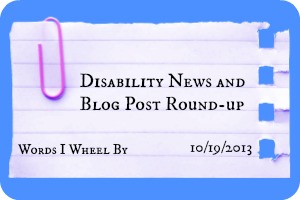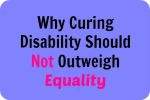 I’m coming off the high of spending five days in my absolute favorite place in the country: Washington, D.C. I know – it’s not exactly everyone’s top choice of locations given the current political climate of the United States. For me though, it’s so exhilarating to be in a city full of people who release the buzz of purpose and potential into the atmosphere. It may sound silly, but being in D.C. makes me feel like I’m in the Disney World of disability rights advocacy.
I’m coming off the high of spending five days in my absolute favorite place in the country: Washington, D.C. I know – it’s not exactly everyone’s top choice of locations given the current political climate of the United States. For me though, it’s so exhilarating to be in a city full of people who release the buzz of purpose and potential into the atmosphere. It may sound silly, but being in D.C. makes me feel like I’m in the Disney World of disability rights advocacy.
I went there to go a conference hosted by the organization where I interned over the summer, the Association of University Centers on Disabilities (AUCD). There’s nothing quite as exciting to me as being surrounded by about 700 people connected by involvement in disability rights advocacy and making progress within the disability world. When I’m in the presence of amazing, established advocates and budding ones like myself, I see real potential to improve access and work towards eliminating social barriers for the disability community. As you can see, I want to be as positive and optimistic as possible about social change.
What I wonder, though, is what happens to the energy after meetings of the mind come to an end and conferences come to a close. I left the AUCD conference having made wonderful connections and some great new friends. I felt energized and found my passion for advocacy renewed. And from the looks of it, I was far from alone in this excitement. A conference as empowering as AUCD’s clearly generates fires within people to return to their daily lives and continue to pursue progress. However, I wonder what kind of progress could be made if the energy and passion channeled within the community of the conference halls could carry beyond that.
Essentially, what I mean to say is that I know there can’t always be huge groups of advocates in the same place at the same time, but I’d love to see what would happen if the collaborative mentality could be there 365 days a year. In the case of AUCD, collaboration is always there, even though members are spread out across all 50 states. That’s what I love about the organization – the efforts don’t stop just because everyone isn’t together under one roof.
However, I find that all too often, I meet advocates from other places, we bond over our passion, and then go right back to smaller, isolated advocacy communities.
The AUCD conference reminded me of how important a true sense of community is to successful advocacy. I found it particularly poignant that the conference theme was Promoting Inclusion in an Increasingly Diverse World, because a sense of community was fostered within the celebration of diversity. Acceptance of diversity won’t happen without understanding the common ground we occupy.
I’m sure you’ve read similar sentiments a million times before, because I know I have. But I keep waiting to see more people taking it to heart. I’m so lucky to call myself a part of some amazing disability advocacy communities, including some great people in the AUCD network, but I’d love to see this sense of community, this sense of connection, grow within the existing community. So much progress has been made since the passage of the Americans with Disabilities Act and other important disability-related legislation, but there is so much more to be done, and no one can do it alone.

 Not a day goes by for me where I don’t come across articles or blog posts related to disabilities that command my attention and make me stop to think.
Not a day goes by for me where I don’t come across articles or blog posts related to disabilities that command my attention and make me stop to think. 
 Every week, I find myself inundated by disability news and information…and I love it. Of course, I don’t mean that I love it when I come across stories of discrimination or mistreatment, or when I read articles that – in my opinion – misrepresent disabled people. Rather, I value the opportunity to access the wealth of resources and opinions on disability that the Internet has to offer. As a bit of an experiment, I’d like to share a round-up of disability-related articles and blog posts from this past week that resonated with me or piqued my interest. I hope you’ll find some food for thought within my lists.
Every week, I find myself inundated by disability news and information…and I love it. Of course, I don’t mean that I love it when I come across stories of discrimination or mistreatment, or when I read articles that – in my opinion – misrepresent disabled people. Rather, I value the opportunity to access the wealth of resources and opinions on disability that the Internet has to offer. As a bit of an experiment, I’d like to share a round-up of disability-related articles and blog posts from this past week that resonated with me or piqued my interest. I hope you’ll find some food for thought within my lists.
